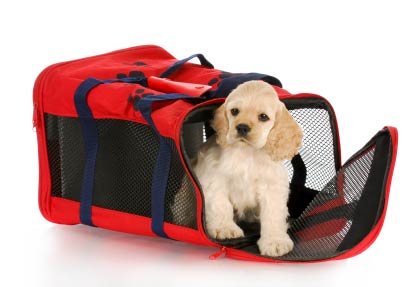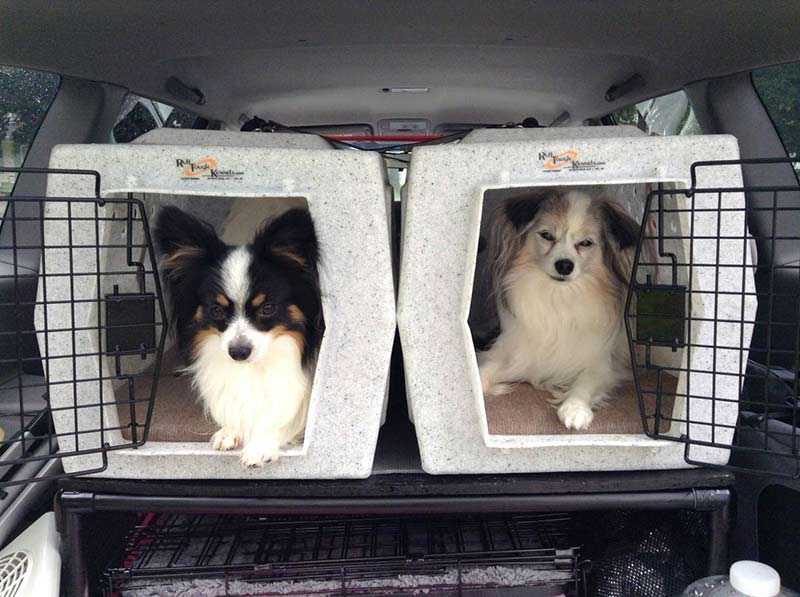Taking your dog on the family vacation can make for a great trip, if you plan carefully.
Are you traveling by car, plane, train, bus, or boat? How long will the trip take? Will you be staying with family or friends, or at a hotel or motel? Is your dog in good health?
These are some of the questions you will need to answer to make your trip safe and fun.
Dog Travel Safety
A crate or harness that attaches to the seat belt should be used for your dog’s safety when traveling. Crates and harnesses are available from most pet supply stores. Be sure to provide plenty of water and a favorite toy to make your dog as comfortable as possible. Also, be sure the crate…
- is large enough to allow the dog to stand, turn and lie down
- is secured to the vehicle
- is strong, with handles or grips, and free of interior protrusions
- has a leak-proof bottom covered with plenty of absorbent material
- has ventilation on opposing sides, with exterior rims or knobs to prevent blocked airflow
- has a “LIVE ANIMAL” label, arrows upright, with owner’s name, address and phone number
Traveling With Dogs by Car
- When traveling by car, be sure to keep your dog comfortable. Bring along a favorite toy to make your dog feel secure.
- If it’s hot, open car windows to provide sufficient ventilation. Do not let your dog stick its head out of the window; this may lead to eye or ear injuries. Also, do not let your dog travel in the back of an open pickup truck. Your dog could be injured in an accident.
- To help prevent motion sickness in your dog, take several short trips in the car before your journey. Also, feed your dog lightly before the trip, about one-third the normal amount.
Traveling With Dogs by Plane
- When traveling by plane, plan to visit your veterinarian before your trip. Certification of health must be provided no more than 10 days before travel. Rabies and vaccination certificates are also required. Your dog should be at least 8 weeks old and weaned.
- Airlines make it clear that it is the owner’s responsibility to verify the dog’s health and ability to fly. Ask your veterinarian if it would be best for your dog to be tranquilized for the trip. Also be sure to check the temperature of the flight’s starting point and destination; it may be too hot or too cold to be safe for your dog.
- Federal regulations prohibit shipping live animals as excess baggage or cargo if an animal will be exposed to temperatures that are below 45°F or above 85°F for more than four hours during departure, arrival, or while making connections.
- Remember that each airline has its own variations on regulations and services. For example, if your crate doesn’t meet its requirements, the airline may not allow you to use it. They may, however, allow your dog in the passenger cabin if your crate or carrier fits under the seat in front of you.
When making your reservations, you must make reservations for your dog. There are restrictions on the number of animals permitted. They are accepted on a first-come, first-served basis.
Traveling With Dogs by Train, Bus or Boat
- If you decide to travel by train, you may be disappointed. Pets are currently accepted only on a limited number of Amtrak trains. (Service dogs are permitted.) For more information on Amtrak’s pet policy, please refer to their website, www.amtrak.com/carry-on-pets. Local and commuter trains have their own policies.
- Travel by bus may be equally disappointing. Greyhound and other bus companies that travel interstate are not allowed to carry live animals, including dogs. (Service dogs are permitted.) Local bus companies have their own policies.
- Federal law (Americans with Disabilities Act) allows equal access to all “Service Dogs” (ie., hearing assistance, mobility assistance, etc.). It is crucial if you are traveling with a service dog to alert the carrier that you are coming with a service dog so that they may accommodate you with special seating, if available. If you travel with a service dog, you need to know those laws and carry a copy of the law with you and the number for the ADA office in the U.S. Department of Justice, (800) 514-0301 (voice) and (800) 514-0383 (TDD). You may come across a gate agent, ticket seller, conductor, etc. who does not know the law.
- If you’re taking a cruise, you may be in luck. For example, the QE2 luxury cruiser, which sails from New York to England/France, provides special lodging and free meals for your dog.
- Check with the cruise line or ship that you are planning to use for its policies. Smaller ships will usually not be able to accommodate your dog.
Dog-Friendly Lodging and Hotels
- If you plan to stay at a hotel or motel, be sure to find out in advance if it allows dogs because many do not.
- If your dog is allowed to stay at your hotel or motel, respect the privacy of other guests. Keep your dog as quiet as possible.
- Beware of leaving your dog unattended. Many dogs bark or destroy property in a strange place.
- Prevent any possibility of unwanted messes or an escape. Keep your dog in its crate at night or if you must, leave it in your room alone. Also, ask where you should walk your dog, and be sure to clean up after your dog.
- Please remember, for hotels to continue to accept guests with dogs, it is important to respect hotel property, staff and fellow guests.
International Travel With Dogs
- International travel involves much more than interstate travel. Each country has its own rules and regulations.
- Many countries have a quarantine period. Check with the embassy or consulate of the country of your destination for details.
- Check with the embassy or consulate of the country of your destination for details.

Other Helpful Tips for Dog Travel
However you travel, keep these tips in mind:
- Make sure your dog has a sturdy leash and collar. The collar should have identification tags, a license and proof of rabies vaccinations. Your home phone number should be on the tags as well.
- You should have a permanent form of ID (such as a dog microchip) that can increase the likelihood of reuniting you with your dog if it gets lost far from home.
- Carry recent pictures of your dog with you. If you are accidentally separated, these pictures will help local authorities find your dog.
- Take the phone number of your veterinarian and any special medication your dog needs. Some dogs can’t adjust to abrupt changes in diet, so pack your dog’s regular food, bowls and a cooler of water.
- If you think you might need to board your dog at some point during your travels, be sure to bring your dog’s complete vaccination records.
Dog Travel Websites
Numerous websites are dedicated to traveling with your pet. Visit www.petswelcome.com, www.doggonefun.com, and www.bringfido.com. All have updated national lists of hotels, campgrounds, resorts and bed-and-breakfasts for you and your best friends.
Dog Travel Directories and Books
- On the Trail With Your Canine Companion: Getting the Most Out of Hiking and Camping with Your Dog, by Cheryl S. Smith, Howell Book House
- Traveling with your Pet: The AAA Petbook: The AAA Guide to More Than 10,000 Pet-friendly AAA Rated Lodgings Across the United States and Canada, by Greg Weekes, American Association of Automobiles
- Vacationing With Your Pet, by Eileen Barish, Pet-Friendly Publications
- Great Vacations for You and Your Dog, USA, Martin Management Books


